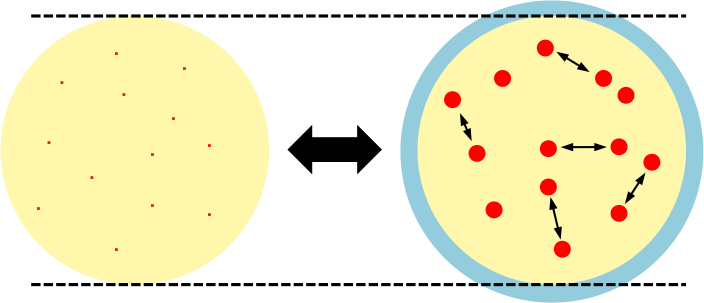The compression factor or compressibility factor measures the deviation of the behaviour a real gas from an ideal gas.
Intermolecular forces can be attractive or repulsive. Attractive forces have a longer range (several molecules in length) than repulsive forces.

Question
Why do attractive intermolecular forces have a longer range than repulsive intermolecular forces?
Answer
The difference in range between attractive and repulsive intermolecular forces boils down to the nature of these forces and how they act over distance. Attractive forces like van der Waals forces, dipole-dipole interactions, and hydrogen bonds decrease in strength more gradually with distance. For example, van der Waals forces decrease with the inverse sixth power of the distance between molecules. This means that even when molecules are relatively far apart, these forces can still exert a noticeable influence. Repulsive forces, on the other hand, are much stronger and decrease more rapidly with distance. These forces arise primarily from the overlap of electron clouds, leading to a strong repulsion due to the Pauli exclusion principle. The repulsive force increases exponentially as the distance between molecules decreases, making it significant only at very short distances.
At high pressures (high compression), repulsive forces between gas molecules are more significant than attractive forces, as the molecules occupy a small volume with small separations between them. The volume occupied by the gas is therefore expected to be larger than that for an ideal gas.
At low pressures (low compression), neither force is significant, as the gas molecules occupy a large volume with large separations between them. The gas therefore behaves ideally (i.e. volume occupied by the gas is expected to be the same as that for an ideal gas) and can be described mathematically by the ideal gas law.
At moderate pressures, attractive forces are more significant than repulsive forces, as the molecules are close enough for intermolecular attraction but not close enough for repulsive forces to be effective. The volume occupied by the gas is expected to be smaller than that for an ideal gas.
We can therefore measure the deviation of a real gas from ideality by analysing the ratio:
where Vm is the molar volume of a gas, and Vmo is the molar volume of an ideal gas at the same temperature and pressure as the gas of Vm.
We call this ratio, Z, the compression factor (or compressibility factor). The possible values of Z are as follows:
|
Pressure |
Z |
|
Low |
1 |
|
Moderate |
< 1 |
| High |
> 1 |
The diagram below shows the values of Z at different pressures for a few gases at the same temperature.

All gases have Z > 1 at high pressures (over 500 atm), Z < 1 at intermediate pressures (0 atm to 500 atm) and Z = 1 as p → 0. Since , eq1 becomes
Eq2 is a simple equation of state that accounts for real gases when Z deviates from 1.

Question
Why is Z > 1 for H2 at intermediate pressures?
Answer
From eq2, Z is a function of temperature T. The diagram above shows a plot of Z for T > 100 K, where Z > 1 for H2 at intermediate pressures. For T < 100 K, Z < 1 for H2 at intermediate pressures. To elaborate further, H2 is smaller than the other gas molecules represented in the diagram. Therefore, we would expect repulsive forces between H2 molecules to be significant at higher pressures. In other words, H2 behaves like an ideal gas, with Z ≥ 1, at low and intermediate pressures for T > 100 K.





